Here’s a peak power calculator, if that’s what you wanted.
Read on if you’re interested in how to measure the real pulse shape of your laser – and use it to calculate the peak power.
When working with pulsed laser sources, laser developers and scientists are often interested in knowing the peak power, the highest power output from the laser. However, most pulsed laser power meters display the total energy of a pulse or alternatively the average power, not the peak power. How can a user measure the peak power of a pulsed laser beam using Ophir laser measurement equipment?
Ophir offers a nanosecond response time photodetector which is designed to measure the temporal behavior of pulsed lasers, the FPS-1 photodetector. The FPS-1 is easily connected to an oscilloscope which displays a temporal trace of the power output during the pulse. Since the oscilloscope does not display a trace of absolute power output over time, but rather the relative pulse behavior and shape, it cannot be used directly to find the peak power. However, with a simple calculation the trace may be used to derive the peak power of a pulse.
In order to measure the peak power of a laser pulse given the oscilloscope trace and the total energy of the laser pulse:
1) Construct a rectangle to represent a pulse with height equal to the peak power in arbitrary units of the oscilloscope trace, and with area equal to the area of the oscilloscope trace. Note the constructed time duration of the constructed rectangular pulse. (This construction can be most easily done by manipulation of the numerical data log of the oscilloscope trace).
2) Since the total energy of the pulse is known, the peak power and consequently the non-arbitrary vertical scale of the oscilloscope trace may be determined by dividing the known total energy of the laser pulse by the constructed time duration of the constructed rectangular pulse.
For example in the trace below let us say the total energy measured is 10mJ.
a) The trace has a peak reading of 55 A.U. (arbitrary units)
b) Sum the reading values in A.U. = total 268
c) Find the approximate area under the trace by multiplying the sum by the step size, 268 * 0.1 ms = 26.8 ms
d) Find the time duration that when multiplied by the peak power in A.U. will give the same area as the preceding.
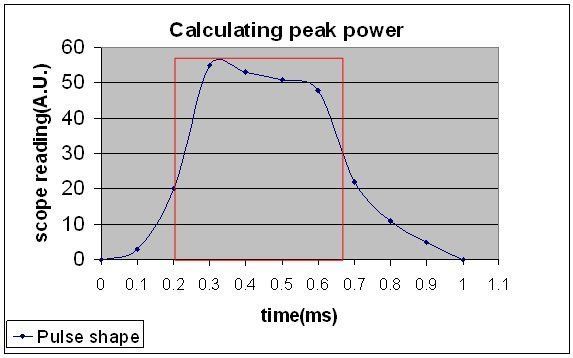
The equation is:
(time duration) = (area under trace) / ( peak power A.U.) i.e.
(time duration) = (26.8 ms)/55 = 0.49 ms.
Thus, for instance if the total pulse energy is 10 mJ, the peak power is 10 mJ divided by 0.49 ms, approximately 20.5 W.
This video also explains how to measure peak power, and includes a lot more about the differences between peak and average power:
You might also like to read:
Laser Peak Power and Average Power: What’s the Difference?
A shortcut for calculating Power Density of a laser beam
Share this:
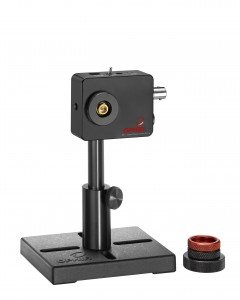

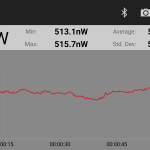

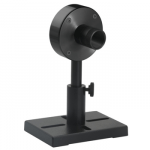

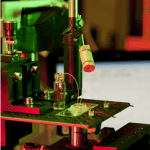
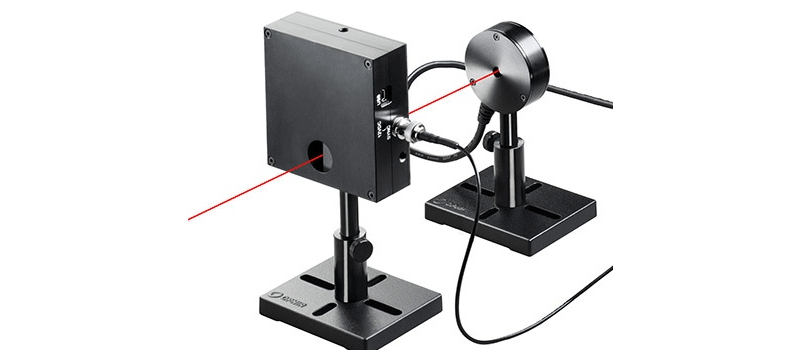
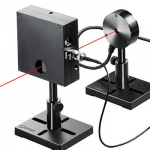


If I am using an oscilloscope to view the pulse shape, would it be more direct and thus more acccurate to use a radiometer and its corresponding responsivity chart and the known photodiode area to determine peak power?
The blog post tells if you know the pulse energy and the temporal pulse shape of the laser how to calculate the peak power.
If you have a radiant power detector that is calibrated and fast enough, then of course you can use that to directly measure the peak power. However, usually people are able to measure the total energy of the pulse accurately but not the power vs. time of a short pulse so therefore the above blog post.